Date With a Katydid
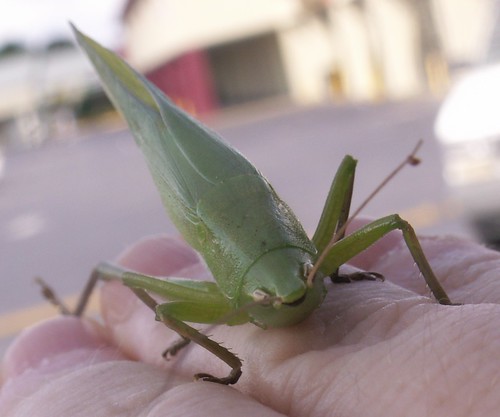
Large view
I'd stopped at the local bakery for coffee in the middle of Tuesday's "post office walk." I was on my second cup when I saw what I first thought was a small piece of paper being blown around in the parking lot. But then the hops seemed a bit too regular to be due solely to wind. I figured it must be an insect, and one that was in some distress.
I didn't realize I was in for a bit of bonding....
I finished my coffee, packed up my things, and all but raced out the door to find a katydid with a bum leg. She seemed to be hopping around fairly aimlessly -- I say "she" because she had an ovipositor.
I wanted to get to her before the bottom of someone's foot or a car tire did.
I coaxed her onto my hand and took her to the nearest vegetation island. Usually the insects I escort off the road are happy to jump onto greenery, but this one clung all the harder to my finger. And that was after our photo shoot, with me working the camera with my non-dominant left hand.
The University of Florida has a terrific Katydid Key that I used to narrow down the species. The U FL site also has recordings of the songs sung by the males of each species. After a bit of consultation I'm fairly sure this is a female broad-tipped conehead (Neoconocephalus triops).
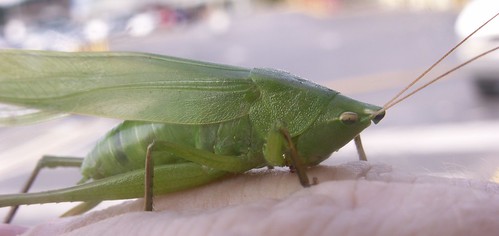
Large view.
Family Tettigoniidae (Katydids). The cone shape of the head means she's in the Subfamily Copiphorinae (coneheaded katydids). "Four genera and 22 species occur in America north of Mexico. All occur in the eastern United States and only 3 species have been found west of Texas," according to U FL.
One genus contains species that possess shorter forewings, so my companion wasn't in that one. Of the remaining three genera, the species of one possess a cone ending in a sharp, downturned point, which is not the case here.
That left two genera, one of which contains species possessing that little notch in the bottom front of the cone. That places my companion in the genus Neoconocephalus, or "common coneheads."
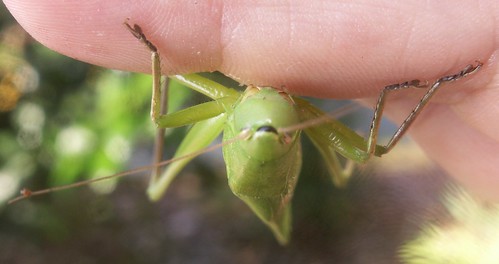
Large view.
The camera has not been rotated. She knew how to hang on. If you look closely you can see her claws.
One of my childhood buddies was a praying mantis that lived in the Rose of Sharon tree in my back yard in Brooklyn. I visited with it, let it crawl on my arm, and then let it crawl back into the tree. It was a quite magical relationship -- and there was something very special about the slight pinch of those claws on my skin. I got the same sensation with this lady.
The dark coloration at the front end of her cone helped me narrow down her species to broad-tripped (triops). The Latin name means "three-eyed." Says Bugguide.Net, "This refers to the black spot on the cone, having the appearance of a third eye."
Every time I tried to set her down among the parking lot vegetation she grabbed my finger as if to say Nooooooooo!, so I headed down to the "post office pond." That meant walking at the edge of a main road for several blocks, down an incline to where the pond was located. Fanny pack behind me, tote bag and camera bag slung over my left shoulder, left hand cradling the camera I wore around my neck, and right hand held out a bit from my body with my friend hanging onto my finger.
Of course I talked to her. "Maybe you'll like the pond. I don't know. You comfy? If you don't like the pond I'll take you home with me. You'll tell me what you like to eat, okay?..."
I almost named her. But the day was hot and the only name I could think of was Katie, which was way too much of a cliche.
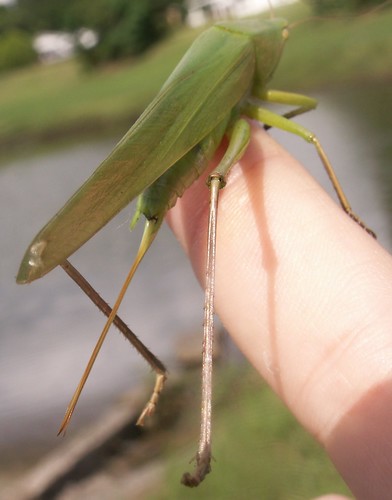
Large view
The background has changed from asphalt to water.
That long slender rod between her legs is her ovipositor. Females are larger than males, and this one was thick enough so that I wondered if she might be gravid (pregnant). I hadn't the foggiest idea. Her right rear leg (the one in the foreground) is the one I think is injured, because it remained relatively unbent as she hopped.
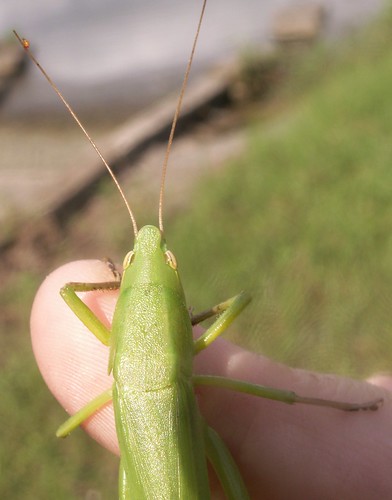
Large view
This top-down (ventral) view of her cone provided another clue as to her species. (U FL: "No other conehead has a cone that is wider than long.") Hence the name "broad-tipped." That very front top part is bulbous.
At the pond I finally convinced her to let go of my finger. She moved a bit toward the water and then remained fairly motionless on the moss. I offered my hand again, but she declined. I figure by this time she's bird food, fish food, happily laying eggs, or is otherwise occupied with whatever occupies katydids.
 | Covenant, the first volume in the Deviations Series, is forthcoming from Aisling Press and can be pre-ordered here. The Deviations page has additional details. |











1 Comments:
My niece and I saw one on a light at the entrance to the Haunted Mansion at Disney last weekend. Found your blog via an image search for Katydid. Great photos!
Post a Comment
<< Home